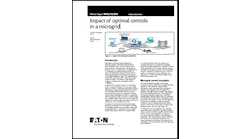In many ways “The War of the Currents” was really about distributed versus centralized generation. In an era of distributed energy resources, the renewables-based DC microgrid puts a new spin on an old debate.
DC versus AC. Tesla versus Edison. The subject has been discussed so much over the years, it has almost become cliché. But looking at this centuries old debate through the lens of today’s drive for cleaner, more resilient energy resources frames the debate in a new light. Really, “The War of the Currents” was about centralized versus distributed power generation as much as it was about whether electrons should provide power by taking a straight path (DC – direct current) or an oscillating one (AC – alternating current). Edison advocated localized generation — what we today know as microgrids — whereas Tesla advocated centralized power plants connected to consumers with long transmission lines.
Today, the modern tools of clean, renewable generation are solar and battery energy storage. Solar allows us to generate clean power, but it is an intermittent resource and only available when the sun is out. Pairing solar with battery energy storage turns solar into a dispatchable energy source, one we can predictably rely on to power our loads. Solar is a DC source, while batteries are a DC load, so putting them together via a “DC coupled” approach means avoiding additional energy conversion losses going from DC:AC as well as additional equipment such as inverters, rectifiers, transformers and switchgear needed when pairing solar and batteries via “AC coupling.”
Digging a little deeper, the renewable-based DC microgrid offers a number of other benefits in a post Tesla-Edison world. While Tesla “won the war” and the AC grid helped turn America into the world’s leading economic superpower, that grid is now in need of major help. Microgrids are a great tool for providing such assistance because they offer pockets of energy resilience to a now badly overcrowded grid. This is where the DC microgrid concept gets really compelling, not just for energy consumers, but for grid operators as well.
For grid operators, DC microgrids are great because they require smaller grid interconnections because they only need a single inverter for both solar and battery, putting less strain on the grid and saving costly upgrades when adding firm, distributed energy resources such as solar and batteries. From the consumer perspective, they are also helpful because when properly designed, DC microgrids allow for very large DC overbuilds where excess photovoltaic (PV) generation can be stored in a battery and used later when the sun is not out, i.e., at night. In microgrids where solar and batteries are connected on the AC side of the inverter, no such “clipping recapture” can occur. In such cases, to capture all of the power of the PV array, you need to use a larger inverter, which costs more and creates a larger interconnect to the grid.
The key to taking advantage of the benefits of such a topology is the creative application of DC:DC converters, such as the ones manufactured by Alencon. DC:DC converters act as valves to “map” the voltage of different DC sources (i.e., solar, fuel cells) and loads (batteries, electric vehicles, DC lighting systems) into a common voltage. Some DC:DC converters, like those made by Alencon, offer galvanic isolation, which means they provide the safety benefits of isolating various electrical circuits like solar and batteries in the same way an isolation transformer does for an AC coupled system, while still allowing the user to harness the benefits of DC microgrids explained above.
Hanan Fishman is president of Alencon Systems.








